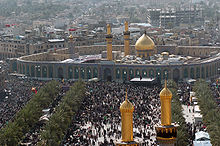Husayn ibn Ali
![]()
The title of this article is ambiguous. For other persons of this name, see Hussein ibn Ali.
Al-Husain ibn ʿAlī (Arabic الحسين بن علي, DMG al-Ḥusain bin ʿAlī; born in Medina in January 626; died 10. October 680 in Karbala), known as Hussein or Hossein (also Hussain) for short, was the younger son of Ali ibn Abi Talib and Fatima bint Muhammad, a grandson of the Islamic prophet Muhammad, and thus a member of the Ahl al-bait.
Al-Husain is a central figure in the Shiite faith. After the death of his brother Hasan in 670, he laid claim to the office of caliph, but is said to have refused action against Muawiya I during his lifetime. In 680 he took charge of a rebellion in Kufa against the ruling Umayyad line of caliphs, but it was quickly crushed. Husain was engaged by the forces of the Umayyad caliph Yazid I at the Battle of Karbala on October 10, 680 (10th Muharram 61 of the Islamic calendar), and was killed in the course of the engagement. According to Shiite tradition, his tomb is located in a mosque in Karbala, in the Imam Husain shrine. In the place where his severed head is said to be buried, there is a shrine in the Umayyad Mosque of Damascus; but there is also a tradition according to which Husain's head rests in the Sayyidna al-Husain Mosque in Cairo.
From his marriage with the Sassanid princess Shahrbanu came his son Ali Zain al-Abidin, the fourth Imam of the Shiites. Another of his sons, Ali Asgar, is said to have died in the battle of Karbala in his sixth month and is revered as a martyr by the Shiites.
Today's descendants of Husain are referred to as Sayyid and also as Husainī.

The mausoleum of Imam Hussein in Karbala

Picture of Hussein with symbolic coffin at Arbain festival in Mashhad
meaning
Husain was seven years old when the last Prophet in Islam, Mohammad, passed away; nevertheless, even in those short years he was involved in important events of the time, including being the representative of Islamic youth with his brother at the event of Mubahala and being among those involved in the event of the Ahl al-kisā'.
Husain is considered the third Imam by the Twelver Shi'ites because of his death in the battle for the caliphate at Karbala and is venerated as a martyr; the first highlight of this veneration is the annual Ashura ceremonies. The numerous mourning ceremonies on Muharram are concluded with the al-Arba'un festival, during which a total of 14.5 million people went to the Imam Husain shrine in 2009.
Imamate
Husain ibn Ali received the leadership mandate (Imamate) after the death of his brother Hasan ibn Ali (670 AD) and thus became the third Shiite Imam. Husain adhered to the peace treaty that Hasan had concluded with Muawiya.
Reign of Yazid I
Muawiya appointed his son Yazid I as his successor, breaking the peace treaty. After Muawiya's death (680 AD), Yazid became caliph and demanded the oath of allegiance from Husain to give legitimacy to his rule. Husain refused and left Medina for Mecca to avoid unnecessary bloodshed. During this time, people from Kufa who learned of Husain's refusal to obey Yazid wrote him letters inviting him to Kufa. To ascertain the loyalty of the Kufites, Husain sent his cousin Muslim ibn Aqil to Kufa to report to him. After Muslim ibn Aqil was hospitably received in Kufa and the Kufites swore allegiance to Husain, he wrote a letter to Husain that people in Kufa were ready to receive him. Thus Husain began his journey from Mecca to Kufa.
Search within the encyclopedia